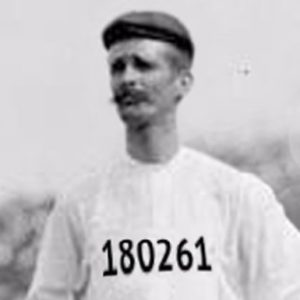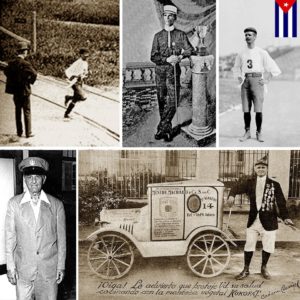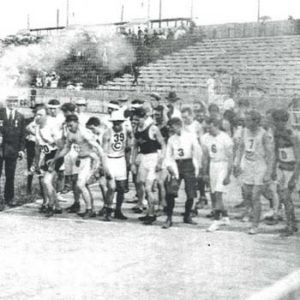 PERSONAJES FAMOSOS CUBANOS: EL FANTASTICO “ANDARIN CARVAJAL”. SU HISTORIA.
PERSONAJES FAMOSOS CUBANOS: EL FANTASTICO “ANDARIN CARVAJAL”. SU HISTORIA.
Félix de la Caridad Carvajal y Soto, conocido como Andarín Carvajal nació un 18 de marzo de 1875 en la calle Águila esquina a San Lázaro en la Habana y niño aún se estableció con sus padres en San Antonio de los Baños.
El andarín Carvajal está todavia en la memoria de algunos habaneros, que suelen recordarlo, sobre todo los más viejos, con una frase: «Caminó (o caminé) más que el andarín Carvajal». Incluso ya anciano recorría kilómetros y kilómetros sin dar muestras apenas de cansancio. No podía dejar de hacerlo. Corría y «pasaba el cepillo». Los magros ingresos que conseguía de ese modo lo ayudaban a vivir.
Félix Carvajal Soto amaba sincera y desinteresadamente el deporte y pese a carecer de orientación en sus entrenamientos, tenía condiciones excepcionales para las carreras de fondo. De haber nacido en otra época tal vez hubiera sido mucha la gloria que habría dado a Cuba. Pero a Carvajal le tocó vivir lo mejor de su existencia durante las décadas iniciales de la República. Los Gobiernos de entonces no lo ayudaron y poco consiguió de la iniciativa privada.
Durante su vida fue un cartero que realizó exhibiciones caminando y corriendo en Cuba (incluyendo un viaje a través de toda la longitud de la isla) y un corredor de fondo que compitió en los Juegos Olímpicos de verano de 1904.
Carvajal viajó a los Estados Unidos para competir en la maratón olímpica en los Juegos Olímpicos de verano de 1904 en St. Louis, Missouri, pero perdió todo su dinero en las apuestas en Nueva Orleans, Louisiana y se vio obligado a hacer autostop y caminar el resto del camino. Llegó a la carrera vestido con ropa de calle y rápidamente se cortó las piernas de sus pantalones para que parecieran más cortos. Carvajal se desempeñó bien en la carrera a pesar de detenerse para conversar con los espectadores y arrebatar algunos duraznos del automóvil de un espectador. Más tarde en la carrera vio un manzano y se detuvo para comer algunas manzanas que resultaron podridas. Después de detenerse para tomar una siesta y recuperarse, Carvajal se recuperó para terminar cuarto.
Carvajal regresó a St. Louis al año siguiente para correr en la maratón inaugural All-Western, donde terminó tercero, en un tiempo de 3:44.
Carvajal fue seleccionado para representar a Cuba en el maratón olímpico de 1906 en Atenas, Grecia, con sus gastos financiados por el gobierno cubano. Sin embargo, desapareció después de aterrizar en Italia, y nunca llegó a Atenas. Se pensaba que estaba muerto, y su obituario se publicó en los periódicos cubanos, pero luego regresó a La Habana en un barco de vapor español.
Luego se convirtió en profesional y venció al corredor de distancia estadounidense Henry W. Shelton en una carrera de seis horas en 1907.
El 8 de mayo de 1909, participó en un Marathon Derby en una pista de seis vueltas por milla en el Polo Grounds de la ciudad de Nueva York con un campo internacional de otros doce corredores de maratón profesionales, el más notable fue Dorando Pietri. Carvajal fue rápidamente lapeado por los líderes después de haber completado la primera milla en 5:02. La carrera fue ganada por Henri St. Yves de Francia en un tiempo de 2:44:05; Carvajal terminó, pero nunca estuvo fuera del último lugar.
Entre otros empleos menores fue portero del hotel Inglaterra y, en sus años finales, conserje del Ministerio de Defensa. Bajo el puente de La Lisa tenía arrendado un terrenito por diez pesos mensuales donde cultivaba frutos menores, que luego trataba de vender en los puestos de vianda cercanos y si no, terminaba regalándolos a sus vecinos. Allí tenía su choza y el carrito que le mandó a hacer el coronel Batista en la Armería Nacional. Parecía un automóvil, pero tenía ruedas de bicicleta. El andarín lo empujaba de día y le servía de dormitorio si la noche lo sorprendía lejos de su casa. En una bandera cubana que conservaba al lado de su cama había prendido todas las medallas ganadas.
Un día, la vaca de un vecino traspuso la cerca del predio de Carvajal y arruinó su sembrado. Intentó el propietario del animal una disculpa, pero el andarín, que tenía muy mal genio, no se la aceptó y llegó incluso a golpearlo. Insistía en personarse con la vaca en el cuartel de la Guardia Rural para que allí exigieran cuentas a su dueño. En medio de esa discusión se desplomó. ¡Una embolia!, gritaron los vecinos. Eran las siete de la tarde del 27 de enero de 1949. En la Casa de Socorros de Marianao, el médico de guardia, en verdad un estudiante de apellido Cabrera, escribió bajo el número 451 del Registro: «Félix Carvajal, blanco, cubano, de 82 años de edad… Al examen médico presenta los síntomas reales de la muerte…».
Días antes, ya enfermo y con los dolores propios de una hernia inguinal, circunvaló La Habana con el corredor argentino Guerrero. Terminaron en el estadio del Cerro —Latinoamericano—, donde dieron varias vueltas al terreno antes de que se iniciara el juego de pelota. El público, puesto de pie, lo ovacionó durante largos minutos. Dijo: «Hice esto porque di mi palabra y nunca he faltado a ella y también para que todos vean que el andarín Carvajal corre todavía».
 CUBAN FAMOUS CHARACTERS: THE FANTASTIC “ANDARÍN CARVAJAL”. HIS STORY.
CUBAN FAMOUS CHARACTERS: THE FANTASTIC “ANDARÍN CARVAJAL”. HIS STORY.
Félix de la Caridad Carvajal y Soto, known as Andarín Carvajal was born on March 18, 1875 in the Águila street corner of San Lázaro in Havana and still a boy settled with his parents in San Antonio de los Baños.
The Carvajal walker is still in the memory of some Havanans, who usually remember it, especially the older ones, with a phrase: “He walked (or walked) more than the Carvajal walker.” Even as an old man he traveled kilometers and kilometers without showing signs of fatigue. I could not stop. He ran and “passed the brush.” The meager income he got that way helped him live.
Félix Carvajal Soto loved the sport sincerely and selflessly and despite lacking guidance in his training, he had exceptional conditions for cross-country racing. If I had been born in another era, perhaps the glory I would have given Cuba would have been great. But Carvajal had to live the best of its existence during the initial decades of the Republic. The governments of that time did not help him and he got little from private initiative.
During his life, he was a postman who made exhibitions walking and running in Cuba (including a trip across the entire length of the island) and a long-distance runner who competed in the 1904 Summer Olympics.
HIS OLYMPIC SUCCESSES
Carvajal traveled to the United States to compete in the Olympic marathon at the 1904 Summer Olympics in St. Louis, Missouri, but lost all his money on bets in New Orleans, Louisiana and was forced to hitchhike and walk the rest of the way He came to the race dressed in street clothes and quickly cut off the legs of his pants to make them appear shorter. Carvajal performed well in the race despite stopping to talk with the spectators and snatch some peaches from a spectator’s car. Later in the race, he saw an apple tree and stopped to eat some apples that were rotten. After stopping to take a nap and recover, Carvajal recovered to finish fourth.
Carvajal returned to St. Louis the following year to run in the inaugural All-Western marathon, where he finished third, in a time of 3:44.
Carvajal was selected to represent Cuba in the 1906 Olympic marathon in Athens, Greece, with his expenses financed by the Cuban government. However, he disappeared after landing in Italy and never arrived in Athens. He was thought to be dead, and his obituary was published in Cuban newspapers, but then he returned to Havana on a Spanish steamboat.
He then became a professional and beat American distance runner Henry W. Shelton in a six-hour race in 1907.
On May 8, 1909, he participated in a Marathon Derby on a six-lap per mile track at the New York City Polo Grounds with an international field of twelve other professional marathon runners, the most notable being Dorando Pietri. Carvajal was quickly lapped by the leaders after completing the first mile at 5:02. The race was won by Henri St. Yves of France in a time of 2:44:05; Carvajal finished, but he was never out of the last place.
Among other minor jobs, he was the doorman of the England hotel and, in his final years, the concierge of the Ministry of Defense. Under the bridge of La Lisa he had leased a little land for ten pesos a month where he grew smaller fruits, which he then tried to sell at nearby food stands and if not, he ended up giving them away to his neighbors. There he had his hut and the cart that Colonel Batista sent him to do in the National Armory. It looked like a car, but it had bicycle wheels. The walker pushed him during the day and served as a bedroom if the night surprised him away from his house. On a Cuban flag that he kept beside his bed, he had lit all the medals won.
One day, a neighbor’s cow crossed the fence of the Carvajal estate and ruined its sowing. The owner of the animal tried an apology, but the walker, who had a very bad temper, did not accept it and even hit it. He insisted on coming with the cow in the barracks of the Rural Guard so that they would demand accounts from their owner. In the middle of that discussion, it collapsed. A stroke! The neighbors shouted. It was seven o’clock in the afternoon of January 27, 1949. At the Marianao Relief House, the doctor on duty, really a student named Cabrera, wrote under the number 451 of the Registry: «Felix Carvajal, white, Cuban, 82 years old … The medical examination presents the real symptoms of death … ».
Days before, already ill and with the pain of an inguinal hernia, Havana circumvented with the Argentine runner Guerrero. They ended up at the Cerro-Latin American stadium, where they went around the field several times before the ball game began. The audience, standing up, cheered for long minutes. He said: “I did this because I said my word and I have never missed it and also for everyone to see that the Carvajal walker is still running.”
Agencies/ Wiki/ Ciroo Bianchi/ Internet Photos/ Arnoldo Varona/ www.TheCubanHistory.com
THE CUBAN HISTORY, HOLLYWOOD.











